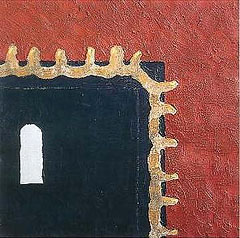 |
||||||
|
Forrest Bess By Barbara Haskell, Curator Whitney Museum of American Art October 7-December 13, 1981 Bess' theory of androgeny and its attendant symbology arose from his anxieties and attitudes about his own sexuality and what he saw as dichotomous aspects of his personality—a polarization manifested in the sensitive, gentle painter on the one hand; the rugged, liquor-drinking fisherman on the other. During the fifties, he became fanatical about disseminating his theory of immortality: he advocated uniting male and female by means of a surgically produced fistula into the male urethra, which made possible urethral orgasm. Bess propounded his theory tirelessly both in letters and in conversation. Eventually, when it proved resistant to acceptance, he felt he had to involve himself physically; beginning in 1960 he underwent a series of operations in an attempt to prove the validity of his hypothesis.
Bess' painting career began when he was twelve and spanned more than six decades. He grew up in the oil fields of Texas, the roughneck son of an itinerant oil laborer. Inspired in part by the fantasy painting of his maternal grandmother, he became interested in art as a child. To appease his father, however, he studied architecture—considered a more masculine pursuit—while attending first Texas A & M University and then the University of Texas. He dropped out in his junior year and went to Mexico, where he remained intermittently for four years, painting in an expressionist style with thickly impastoed paint and dark colors. He returned to the United States during World War II and served in the Army Corps of Engineers, rising to the rank of captain before acknowledging that he could not reconcile the conflicting aspects of his personality—masculine and feminine—in such a world.
During the lean years he found solace with a few friends—in particular Harry Burkhart and his friend Jim Wilford; Mary and Earle Ludgin; and Betty Parsons. Parsons gave him a one-man show in 1949 followed by shows in 1954, 1957, 1959, 1962, and 1967. Despite her encouragement and the enthusiastic support of Meyer Schapiro, Bess' work received little notice during his lifetime except from fellow artists. After his last show with Parsons in 1967, his reputation went into virtual eclipse. He became increasingly eccentric in the early seventies, during the time when his rhinophyma, a nodular swelling of the nose, was becoming more pronounced; after a brief period in a mental hospital, he was admitted to a nursing home in Bay City. He died there on November 11, 1977, a victim of skin cancer exacerbated by long hours in the sun.
What Bess left was a body of richly poetic works unequivocally derived from his inner being. Yet despite the specificity of his iconography, the impact of Bess' paintings does not depend on deciphering his pictorial vocabulary; rather, it rests on the power of his visual images to evoke universal responses quite apart from the paintings' obscurely personal origins. Their directness and authenticity speak to the art of today. Creating an idiosyncratic symbolism which is simultaneously personal and universal, and exploiting expressive paint surfaces are pictorial achievements shared by many of today's artists. Meyer Schapiro, in his essay for Bess' retrospective exhibition at the Betty Patrons Gallery in 1962, called him a "real visionary," not inspired by "texts of poetry or religion but moved by a strange significance of what he alone has seen."
|
||||||

